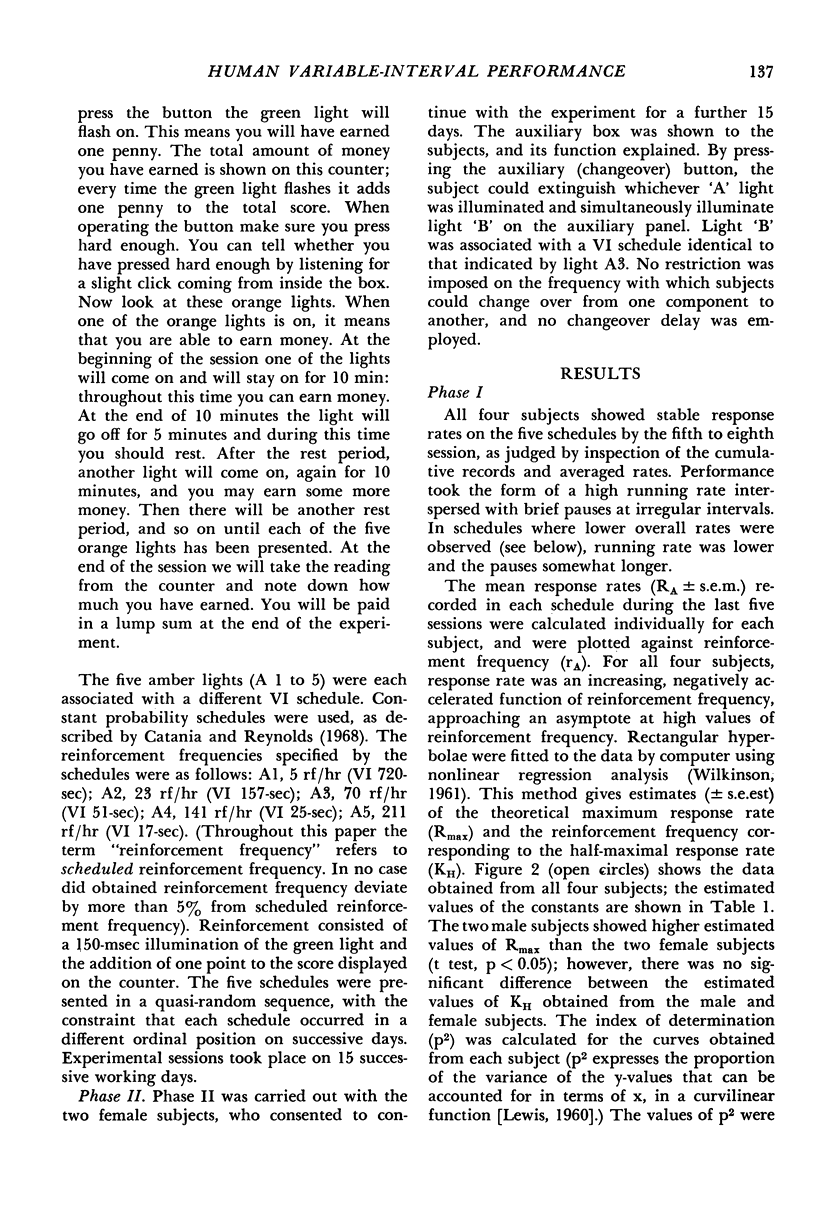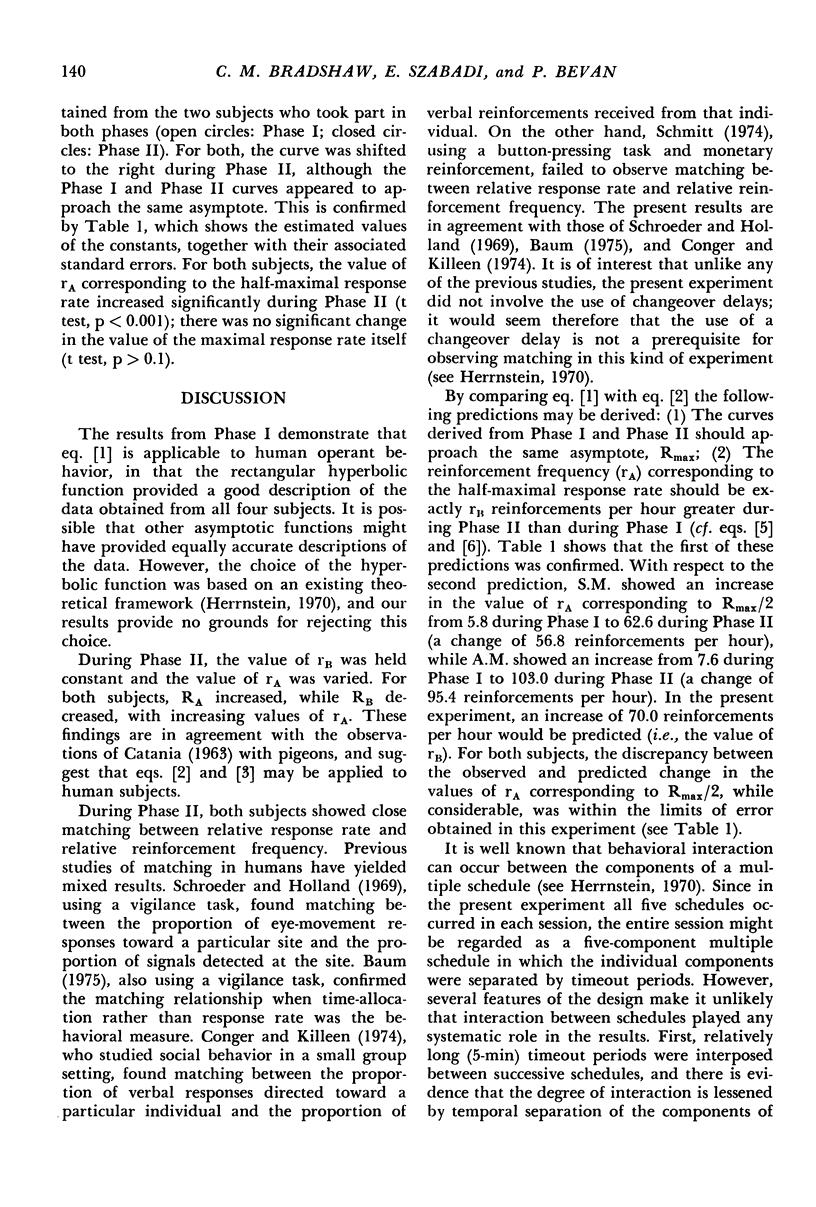Abstract
During Phase I, human subjects pressed a button for monetary reinforcement in five variable-interval schedules, each of which specified a different frequency of reinforcement. The rate of responding was an increasing, negatively accelerated function of reinforcement frequency; the data conformed closely to Herrnstein's equation. During Phase II, the same five schedules were in operation, but in addition a concurrent variable-interval schedule (B) was introduced, responses on which were always reinforced at the same frequency. Response rate in component A increased while the response rate in B decreased, as a function of the reinforcement frequency in component A. Relative response rates in the two component schedules matched the relative frequencies of reinforcement. Comparing the absolute response rates in component A during Phase I and Phase II it was found that introduction of the concurrent schedule did not affect the value of the theoretical maximum response rate, but did increase the value of the reinforcement frequency needed to obtain any particular submaximal response rate.
Keywords: Herrnstein's equation, response rate, reinforcement frequency, matching law, concurrent schedules, variable interval, button pressing, humans
Full text
PDF






Selected References
These references are in PubMed. This may not be the complete list of references from this article.
- BONEAU C. A., AXELROD S. Work decrement and reminiscence in pigeon operant responding. J Exp Psychol. 1962 Oct;64:352–354. doi: 10.1037/h0047944. [DOI] [PubMed] [Google Scholar]
- Baum W. M. Time allocation in human vigilance. J Exp Anal Behav. 1975 Jan;23(1):45–53. doi: 10.1901/jeab.1975.23-45. [DOI] [PMC free article] [PubMed] [Google Scholar]
- Bradshaw C. M., Szabadi E., Bevan P. Human variable--interval performance. Psychol Rep. 1976 Jun;38(3 Pt 1):881–882. doi: 10.2466/pr0.1976.38.3.881. [DOI] [PubMed] [Google Scholar]
- CATANIA A. C. Concurrent performances: reinforcement interaction and response independence. J Exp Anal Behav. 1963 Apr;6:253–263. doi: 10.1901/jeab.1963.6-253. [DOI] [PMC free article] [PubMed] [Google Scholar]
- Catania A. C., Reynolds G. S. A quantitative analysis of the responding maintained by interval schedules of reinforcement. J Exp Anal Behav. 1968 May;11(3 Suppl):327–383. doi: 10.1901/jeab.1968.11-s327. [DOI] [PMC free article] [PubMed] [Google Scholar]
- Catania A. C. Self-inhibiting effects of reinforcement. J Exp Anal Behav. 1973 May;19(3):517–526. doi: 10.1901/jeab.1973.19-517. [DOI] [PMC free article] [PubMed] [Google Scholar]
- HERRNSTEIN R. J. Relative and absolute strength of response as a function of frequency of reinforcement. J Exp Anal Behav. 1961 Jul;4:267–272. doi: 10.1901/jeab.1961.4-267. [DOI] [PMC free article] [PubMed] [Google Scholar]
- Herrnstein R. J. Formal properties of the matching law. J Exp Anal Behav. 1974 Jan;21(1):159–164. doi: 10.1901/jeab.1974.21-159. [DOI] [PMC free article] [PubMed] [Google Scholar]
- Herrnstein R. J. On the law of effect. J Exp Anal Behav. 1970 Mar;13(2):243–266. doi: 10.1901/jeab.1970.13-243. [DOI] [PMC free article] [PubMed] [Google Scholar]
- PLISKOFF S. S. RATE-CHANGE EFFECTS WITH EQUAL POTENTIAL REINFORCEMENTS DURING THE "WARNING" STIMULUS. J Exp Anal Behav. 1963 Oct;6:557–562. doi: 10.1901/jeab.1963.6-557. [DOI] [PMC free article] [PubMed] [Google Scholar]
- Schmitt D. R. Effects of reinforcement rate and reinforcer magnitude on choice behavior of humans. J Exp Anal Behav. 1974 May;21(3):409–419. doi: 10.1901/jeab.1974.21-409. [DOI] [PMC free article] [PubMed] [Google Scholar]
- Schroeder S. R., Holland J. G. Reinforcement of eye movement with concurrent schedules. J Exp Anal Behav. 1969 Nov;12(6):897–903. doi: 10.1901/jeab.1969.12-897. [DOI] [PMC free article] [PubMed] [Google Scholar]
- Shimp C. P., Wheatley K. L. Matching to relative reinforcement frequency in multiple schedules with a short component duration. J Exp Anal Behav. 1971 Mar;15(2):205–210. doi: 10.1901/jeab.1971.15-205. [DOI] [PMC free article] [PubMed] [Google Scholar]
- Shull R. L., Pliskoff S. S. Changeover delay and concurrent schedules: some effects on relative performance measures. J Exp Anal Behav. 1967 Nov;10(6):517–527. doi: 10.1901/jeab.1967.10-517. [DOI] [PMC free article] [PubMed] [Google Scholar]
- Silberberg A., Fantino E. Choice, rate of reinforcement, and the changeover delay. J Exp Anal Behav. 1970 Mar;13(2):187–197. doi: 10.1901/jeab.1970.13-187. [DOI] [PMC free article] [PubMed] [Google Scholar]
- Todorov J. C. Component duration and relative response rates in multiple schedules. J Exp Anal Behav. 1972 Jan;17(1):45–49. doi: 10.1901/jeab.1972.17-45. [DOI] [PMC free article] [PubMed] [Google Scholar]
- WILKINSON G. N. Statistical estimations in enzyme kinetics. Biochem J. 1961 Aug;80:324–332. doi: 10.1042/bj0800324. [DOI] [PMC free article] [PubMed] [Google Scholar]
- Wilton R. N., Gay R. A. Behavioral contrast in one component of a multiple schedule as a function of the reinforcement conditions operating in the following component. J Exp Anal Behav. 1969 Mar;12(2):239–246. doi: 10.1901/jeab.1969.12-239. [DOI] [PMC free article] [PubMed] [Google Scholar]


